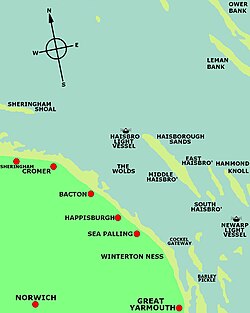Haisborough Sands
Haisboro Sands or Haisbro Sands | |
|---|---|
 Location map of Haisborough Sands | |
 | |
| Coordinates: 52°54′N 1°42′E / 52.900°N 1.700°E | |
| Location | Southern North Sea, United Kingdom |
| Area | |
| • Total | 31.249 km2 (12.065 sq mi) |
| Dimensions | |
| • Length | 16 km (9.9 mi) |
| • Width | 1.6 km (0.99 mi) |
Haisborough Sands (or Haisboro Sands or Haisbro Sands) is a sandbank off the coast of Norfolk, England at Happisburgh.[1] The shoal is 10 miles (16 km) long and 1 mile (1.6 km) wide and lies parallel to the north-east coast of Norfolk. The shoal is marked to the northwest by north by the Haisbro Light Buoy, North cardinal. To the southeast by south is a light buoy South cardinal, and to the west by Mid Haisbro light buoy starboard hand. In 1995 there were three drying patches[clarification needed] recorded to the north-northeast and east-southeast of the Mid Haisbro light buoy. Except at slack water their positions are indicated by tidal eddies particularly on the northwest, and in slight or moderate seas the swell breaks on the shallower parts of the banks. There are several foul patches[clarification needed] on the southern part of the shoal. Over the years this shoal has claimed many ships.[2]
Description
[edit]Haisborough Sands forms part of the Haisborough, Hammond and Winterton Special Area of Conservation. The main ridge of the shoal is made up of five distinct areas. These are named Haisborough Sand, Haisborough Tail, Hammond Knoll, Winterton Ridge and Hearty Knoll. To the eastern edge of the sands there are areas called Hewett Ridge and Smiths Knoll which form a ridge of sandbanks on the outer boundary of the sands. Inshore and to the west there are additional banks including Winterton Shoal and the Newarp Banks.[3]
Fish and mammals
[edit]Haisborough Sands and its surrounding shoals are known to be spawning grounds[3] for Sand eels Ammodytes, Lemon sole Microstormus Kitt and sole Solea solea. The sands also provide nursery grounds for Cod Gadus morhua, Herring Clupea harengus, Mackerel Scomber scombrus, Sole, Lemon sole and Plaice Pleuronectes platessa.[3] There are small numbers of Harbour porpoise regularly observed within the boundaries of the sands. The common seals Phoca vitulina which are resident in the Wash are occasionally observed in this area.[4]
Ships wrecked on Haisborough Sands
[edit]Some of the ships wrecked here include:
- HMS Bideford New Year's Eve 1761/2
- HMS Invincible – 16 March 1801
- Yacht Zoe on 24 May 1857 [5]
- Barque Speculator on 6 December 1875 [6]
- SS Chicago – 1878[7]
- SS Bywell Castle on 10 February 1883.[8][9][10]
- Barque Brownrigg on 12 August 1888
- SS Cambria after a collision with SS Killingworth on 14 May 1891
- Barque Ceylon of Christiania, Norway, 1893
- Optima ex Placilla – 18 January 1905[11]
- SS Atbara of London on 11 February 1907
- An un-named steamer – 1907[12]
- Barque Alf of Laurvig, Norway on 23 November 1909[2]
- SS Bodil of Esbjerg on 26 May 1915
- SS Camille on 6 January 1916
- SS Kronprindsesse Victoria of Haugesund, Norway. 26 November 1917
- SS Georgia – 1927[2]
- SS Monte Nevoso during 14–16 October 1932[13]
- SS Meriones[2] 26 January 1941[13]
- SS Gallois;[2] part of Convoy FS 559 on 6 August 1941
- SS Oxshott[2] of London; part of Convoy FS 559 on 6 August 1941
- SS Aberhill[2] of Methil, Fife; part of Convoy FS 559 on 6 August 1941
- SS Taara[2] of Pärnu, Estonia; part of Convoy FS 559 on 6 August 1941
- SS Paddy Hendly[2] on her maiden voyage; part of Convoy FS 559 on 6 August 1941
- SS Deerwood[2] of London; part of Convoy FS 559 on 6 August 1941
- SS Betty Hindley;[2] part of Convoy FS 559 on 6 August 1941
- SS Afon Towy on 6 August 1941
- HM Trawler Agate (referred to as T87 by the Admiralty[2]); part of Convoy FS 559 on 6 August 1941
- Trawler MV Cuttlefish – 1981[14]
- City of Sunderland – 2008[15]
- Muros – 3 December 2016 [16]
Gallery
[edit]-
The SS Monte Nevoso marooned on the Haisborough Sands
-
Admiralty chart of Haisborough Sands
-
Chart of the Haisborough Sands Lighthouse
See also
[edit]- Happisburgh Lifeboat Station
- Hammond's Knoll - nearby sandbank, similarly treacherous
- Scroby Sands
References
[edit]- ^ SC1408 Harwich and Rotterdam to Cromer & Terschelling Admiralty Small Craft Chart Coastal planning chart of the Harwich and Rotterdam to Cromer and Terschelling Scale: 1:300,000
- ^ a b c d e f g h i j k l The Ship-Wrecks off North East Norfolk by Ayer Tikus: Published by Ayer Tikus Publications; ASIN B0032Z2NU0
- ^ a b c Special Area of Conservation (SAC): Haisborough, Hammond and Winterton
- ^ Scira Offshore Energy Ltd., 2006; Centrica, 2007
- ^ "Loss of Lord Yarborough's yacht the "Zoe"". The Nautical Magazine: 389–390. 1857.
- ^ "Disasters at Sea". Reynolds's Newspaper. No. 1322. London. 12 December 1875.
- ^ "The Ships List: Furness Line". Archived from the original on 25 May 2011. Retrieved 6 August 2008.
- ^ "Overdue". The Times. No. 30740. London. 10 February 1883. col D, p. 12.
- ^ "Supposed Loss of the Steamer Bywell Castle". Daily Gazette for Middlesbrough. No. 4880. Middlesbrough. 10 February 1883.
- ^ "Shipping Disasters". Liverpool Mercury. No. 10949. Liverpool. 13 February 1883.
- ^ "Placilla (1892)". Retrieved 31 December 2008.
- ^ "Nuggets of information". RNLI. Archived from the original on 18 May 2011. Retrieved 6 August 2008.
- ^ a b "Henry Blogg, the Greatest of the Lifeboatmen", Jolly, C., Pub: Poppyland Publishing, new edition 2002, ISBN 0-946148-59-7
- ^ "Fleetwood Online Archive of Trawlers". Retrieved 6 August 2008.
- ^ "Maritime Accident Casebook". 15 January 2008. Retrieved 6 August 2008.
- ^ "Grounding of bulk carrier Muros". GOV.UK. Retrieved 26 November 2019.


